How Indian IT Workers Discriminate Against Non-Indian IT Workers
Executive Summary
- Internationally, Indians have demonstrated a pattern of discriminating against non-Indian workers.
- With the growing concentration of Indians in IT, this is a problem for domestic IT workers worldwide.

The more Indians know what a domestic IT worker does, the more they can determine if someone they know can replace that domestic worker with an Indian friend or acquaintance.
Introduction
Indian discrimination against non-Indians and other out-group Indians is pervasive in the IT sector in locations where Indians have emigrated. This type of discrimination is considered normal in India. This discrimination is invisible and uncovered by the major IT media entities that receive advertising money from major corporations that are part of the H1-B lobby, whose goal is to push down the wages of domestic workers. For this reason, the article you are about to read will appear dramatically different than any article published by any significant IT media entity.
Our References for This Article
If you want to see our references for this article and other Brightwork articles on Indian IT at any time, click this link.
The Convergence of Reports from All Directions
The first items we wanted to present are quotations from Quora. This is so that before we get into our analysis, we wanted to provide quotations on the topic we had nothing to do with creating. Indians who push back on this story generally propose that the entire situation is made up and that Indians do not demonstrate the pattern described in this article. However, public and privately shared comments paint the same picture. These quotations illustrate a convergence of observations on Indian discrimination against non-Indians. It will be shown that explained discrimination is more narrow than this, with the discrimination being for a particular subset of Indians versus both non-Indians and other Indians.

Domestic workers who get Indian bosses usually don’t enjoy the experience. Indian standards for labor are terrible in India, and abuse is common. Abuse is the norm in India, covered in the article How the Awful and Abusive Indian Employment System Works.
India has never developed a system of regulations that protect employees. Bonded labor is considered normal and acceptable in India. India does not have what those in the developed world would find a functioning government. The Indian government is so corrupt it has made no progress on a host of quality-of life-issues since the British left India over 73 years ago.
- India’s population continues to grow, but things are getting worse.
- Indian income inequality has increased over the past several decades. Even issues like water management are a massive problem.
More than 600 million Indians face “acute water shortages,” according to a report last summer by NITI Aayog, a prominent government think tank. Seventy percent of the nation’s water supply is contaminated, causing an estimated 200,000 deaths a year. Some 21 cities could run out of groundwater as early as next year, including Bangalore and New Delhi, the report found. Forty percent of the population, or more than 500 million people, will have “no access to drinking water” by 2030. – Technology Review
The Indian Rights To Jobs In Non-India Derived Countries
Indians who emigrated to European-based countries think they are obtaining rights because they are so amazing, but what they do not realize is that they are leveraging systems of regulations and laws that they had nothing to do with building. All they did was jump on an airplane, allowing them to benefit from hundreds of years of European based progress. However, Indians don’t see it this way. To their mind, they earned all of the benefits created by entirely different cultures. Not only are they usurpers of these rights, but they actively undermine these rights when in the position to do so. Indians benefit from open European based societies and then work to “Indianify them” as quickly as possible as covered in the article How Indians Exploit US Diversity Rules While Practicing Extreme Levels of Discrimination.
Furthermore, they seem to believe that more Indians also deserve this.
As for improving conditions in India, it is well known that it is impossible. As for fighting for union rights in India, this will also never happen. Indians are too corrupt. But Indians will migrate to European-based systems, and both benefit from and, at the same time, degrade the labor rights within those countries. They have done this by bringing discrimination into the labor markets where they have migrated, acting as recruiters, and creating contractual documents inconsistent with the labor standards in these countries.

Evidence for this degradation of labor standards is found in how Indian recruiting companies offer contracts to domestic employees that are entirely contrary to US employment norms, as we covered in the article Contract Clauses to Watch Out for In Indian Professional Service Agreements. This recruiting company that was profiled in this case study not only offered this contract but then lied about the clauses within the contract.

When Indian firms are caught violating US employment law, they pay fines. When the US government receives these funds, it does nothing for US domestic workers; it consumes the funds. However, the damaged parties are the domestic workers, not the US Government. The fines are never enough to alter behavior.
Breaking the H1-B Laws and Easily Paying out the Fines
However, at the fines imposed of 1 million dollars or 34 million dollars paid out occasionally, Indian firms can afford to pay out fines indefinitely. That is, they can see it as a cost of doing business. None of the Indian firms in IT have employee compositions that look anything like the typical demographics in the countries they operate outside of India. However, these firms could argue that because they are terrible companies to work for, only nearly no Americans would want to work there. However, even though they freely discriminate, the US does not bring action against them. This allows the Indian firms to continue acting as they always do.
How The Major Indian Consulting Firms Displace Domestic Workers from Jobs
When Infosys, WiPro, or TATA sell a project in the US or Europe, the team will be primarily Indian. Domestic workers lose jobs when this happens. Many companies like Cisco, IBM, Oracle, and HPE are founded in the US, and their heritage and their perception are highly Indian. And domestic firms that become Indian seem to go in one direction. That is, they become progressively more Indian. IBM stopped reporting employment by country because IBM has been laying off domestic workers in primary markets for IT services (US, Europe, Australia, Canada) and replacing them with Indian workers. Intel has been classifying Indian workers as domestic also to hide the fact that Intel is becoming increasingly Indian.
How The Indian Bias Against Non-Indians Extends to Indians in a Tribal Manner
“So is there a bias towards Indians while hiring for IT positions in Indian-run companies? Definitely. And that too, it’s a bias only towards a small sub-section of Indians.”
For the domestic workers, it is not particularly material if Indians discriminate against Indians who are not part of whatever the in-group appears to be. This is because the majority of Indians who immigrate to developed countries discriminate against the domestic population within that country. It cannot be said that because Indians discriminate against other Indians as well, that discrimination is not an issue. When Indians discriminate against the domestic population, they violate US anti-discrimination laws. The problem is the perception and unequal treatment of those who claim discrimination. That discrimination is only discrimination if some groups undertake discrimination. Other groups demonstrate high levels of discrimination and can’t be charged with doing so. At least, that appears to be the logic.

Indians are renowned for falsifying their resumes. The Indian term for this is “spicing” the resume. Indian firms such as Infosys, Wipro, and TATA are famous for doing this. There are also many cases where one Indian will take an interview, but another will appear for the job. It takes a while to figure out that the person that is showing up to work is not the person interviewing.
Experiences from Singapore With Those Discriminated Against by Indians
Indian immigrants’ behavior is similar to that of the world over. The following quotation is from a commenter from Singapore.
“They created a lot of new manager roles so that they can send their friends in. 5 years ago, we had 1 manager and 15 guys. Now, 7 guys with 3 managers! (The rest left of moved). They force people out by abusing their power. Every year, they have to publish a organization chart. When they realized that all the managers are Indians,(In Singapore, they are not the absolute minority, but definitely low in numbers.) they gave an organization chart without picture! No one will notice that right? Except we are the only region in the world that does not have a picture on the organization chart! So in the end, Indian managers are definitely having some big problems. But due to the political correctly, they can do it. But we can’t point it out. “Racialism “ I guess.”
It is impossible to know this commenter’s race, but most of Singapore’s population is ethnic Chinese. Therefore, it is curious that it may also not be possible for an ethnic Chinese Singaporean to call out this behavior for fear of being called racist.

India is a strongly hierarchical society that allows for minimal questioning. Europe-based countries would need their clocks to turn back hundreds of years to approximate the lack of participation from the lower levels allowed in India.
This commenter brings up this point.
“In the end they aim to take over our IT industry and replace all workers with Indians.”
Yes, and what is stopping this? This is not normal immigration; it is to bring in so many Indians that they flood specific labor markets and take over that market, as is covered in the article How Indians Flood the US Market with Indian Resources.
US Companies With Significant Percentages of Indians Are Now Bocking Out Non-Indian Employment in IT
Indians do not interview non-Indians about whether the interview candidate is the best person for the position. That is a meritocracy, and this is not what Indians are about. Indians need to block out more non-Indians from employment in their company. This is covered in the article Things to Watch Out for When with Interviewing with Indians for IT Positions.
Can a Domestic Worker be Successful in a Predominantly Indian Company Or Indian Environment?
If you have read this far, you can probably guess the answer. The answer is no, as is covered in more detail in the article Can a Non-Indian Worker Be Successful in a Predominantly Indian Company Or Indian Environment? As Indians have come to dominate IT in so many countries, this question is critical to people who need to continue working.
Indian Dominance in IT Recruiting
Indians have taken over not only IT jobs but also IT recruiting and forced out domestic IT recruiters. Our email inbox is frequently the recipient of IT recruiters who are primarily Indian. This takeover of IT recruiting has occurred over an even shorter period than IT employment. It is now uncommon to find domestic IT recruiters. The only conclusion is that domestic IT recruiters have been forced from the market. Secondly, when we compare the rates offered by Indian recruiters, the rates are always lower than for domestic recruiters. This is a shocking and unanticipated outcome of the H1-B Visa program. Initially intended for highly skilled candidates, now nearly anyone qualifies. Indian immigration and workplace discrimination have not only reduced domestic employment in IT, but domestic employees must now mostly go through Indian recruiters, many of whom are calling from India. It will be unsurprising if Indian recruiters prefer to place Indian candidates.
Bringing Over Indians — So They Can Control US IT Recruiting
Indian recruiters are a primary area of discrimination against domestic US IT workers. It is amazing to contemplate that Indians immigrate to the US and then, within just a few years, actively block US domestic workers from getting jobs by taking over the recruiting function within the country for IT workers.
The following articles cover this very important subject.
The Terrible Rise of Indian Recruiters
Why Dealing with Indian Recruiters is Futile for Domestic Workers
How Indian Recruiters Gain Access to Unpublished IT Roles
A Fantastic and Must Read Email on Horrible Indian Recruiters
How to Spot Indian Recruiter Emails Pretending Not to Be Indian
The Typical Indian Predator Company Collabera Recruiting
Rigging Job Descriptions for H1-B Entry
It is difficult not to notice how specific many IT job descriptions have become. Many job descriptions essentially describe a candidate that does not exist. This is a specific strategy by Indians to block domestic workers from jobs, as is covered in the article How Indians Rig Job Descriptions To Block Domestic Employment And Enable H1-B Entry.
 India scores 140 out of 180 countries in press freedom.
India scores 140 out of 180 countries in press freedom.
Indian Respect for Freedom of Speech and of the Press
India has historically never had any freedom of speech or the press. This is how India has remained the twelfth most income-unequal country in the world. This inequality is also why India is such a hotbed for bonded labor. To maintain this level of income inequality, suppression of freedom of speech is necessary. And most Indians will oppose this article. They will oppose even the right for it to be written. In fact, on a different topic an Indian employee of IBM did not like something published at Brightwork Research & Analysis and essentially claimed the right to state that it should not be published as we cover in the article Should an IBM Employee Determine What a Research Entity Publishes?
Again, freedom of speech is part of US law; it is respected in Europe and countries based on European systems, not Indian law, and the established preference is for Indian law…..but not in India, in the US. India cannot change internally because India has shallow freedom of the press. According to Reporters without Borders, India ranks 138 out of 180 countries in press freedom. That is what Indians can accomplish when the entire society is Indian.
Articles written in the Indian media have a distinct stamp of being censored or self-censored, and there is no Indian media outlet that is prominent or read outside of Indian readers.
Finding Other Groups As Frequently Accused of Discrimination as Indians
Brightwork Research & Analysis is a research entity. We are known for tackling issues that almost no one else will. We approached this topic as a research question, and we found damning evidence against Indian employment or workplace discrimination that is only reinforced by what we have seen on many projects. This Indian employment discrimination is not limited to the US but is found in Asia, Australia, Europe, and Africa. The standard defense by Indians will naturally be that this is all a racist illusion by a white author. However, Indians are being accused of discrimination worldwide. And they are being charged with discrimination by non-whites. If this is all a giant racist conspiracy, it is not only extremely widely reported, but the same reports are coming in from many different areas. The author did not write all of the quotations in this article.
- Companies in IT globally are becoming Indian at astonishing rates. IBM has so aggressively fired domestic workers and hired workers in India and Indian workers that they refuse to publish their employment by country. However, IBM has kept its rates where they were previously, which has allowed them to mask the company’s overall decline. It seems impossible for this to happen without something underhanded occurring. It is very difficult to find a field that has switched dramatically to a new group of immigrants in a few decades. And not only a group of immigrants (which has never happened in US history) but a group of immigrants primarily from one part of India.
- We could find no other race or group that was as frequently accused of employment or workplace discrimination as Indians. For these observations to be false, there would have to be a vast conspiracy to promote the reporting of accusations against Indians and no other group.
- The author has witnessed this discrimination firsthand, and we receive new reports of discrimination quite frequently.
The Issue With Higher Caste Indians in India
A reader gave us an interesting quote, describing the issue of higher caste Indians in India.
The higher castes especially Brahmins & Banias are injurious not only to India but wherever they are penetrating.
Indian bureaucracy is full of these castes called “Swarnas” who are highly prejudiced against Indian Muslims, Dalits, and subalterns in every walk of life. They soon may spoil the American system too.
Note it they are concentrating only to IT sector since third rate IT institutes proliferated to award degrees for namesake. However, Indians having American degrees are really worthy but they are in the sectors other than IT. Thus visa restriction on IT sector can save US big corporations from the onslaught of mediocre IT professionals of India.
Conclusion
As bad as they are, the problems laid out in this article are set to become even worse. The continual emigration of Indians to non-Indian countries is leading to negative consequences for domestic workers in each country.

The Large Financial Incentives to Continue Indian Immigration
Consider that Indians are now a highly concentrated interest group in each country that has accepted Indians to continue the various H1-B type programs. Fortunes have been made on Indian labor, promoting its continuance of the status quo. There is no opportunity to attain much wealth in India as low pay persists — for millions of Indians, the only chance to improve their lives is to immigrate to a (primarily) European-based country. The number of open slots only limits the number of people leaving India. This hostility in the work environment against domestic workers in areas ranging from Singapore to Australia to the US to Europe and elsewhere is part of how Indian workers are continually pushing domestic workers out of IT employment. Two sources dispute the demonstrated discrimination against non-Indian workers.
- Indians: Indians will often say that these independent observations are incorrect. The strategy only works if it is not declared. If Indians were to say that they intend to bring practices of nepotism and discrimination over to the countries they immigrate to, then the game would be up.
- Indian Companies: Most of their statements revolve around disputing that they violated the employment or visa laws in the countries of the primary IT markets or hiding the massive rise in Indian employment.
- Domestic Companies: These companies don’t address this issue. They continue to beat the drum, and they need skills.
Selling a Fake Story About Indian IT Employment
Indian workers and employing companies use terms like skills when describing H1-B quotas and hiring, but this is an oversimplification of the actual factors that are driving H1-B and the highly disproportionate hiring of Indian workers. Other terms like income inequality, lower pay, job loss for domestic workers, the creation of hostile work environments for domestic workers, and workplace discrimination by Indians against non-Indians need to become more publicly associated with importing Indian workers.

Most Indians and many Americans have no idea that the rights they enjoy are because unions fought for them. Indians made no such improvements to living conditions in their country. This is one reason they seek to exit the country and gain entry into countries where this has been done for them already. In speaking with several Indians, it is clear that they are entirely unaware of this history.
Major media outlets hide the union battles that have been fought in the US because the behavior on the part of companies was so appalling and because major financial interests do not want people thinking in terms of unions.

Notice how the share of income changes depending on how strong and prevalent unions are. In IT, there has been a dramatic income transfer away from domestic workers, towards the top 10%, and to Indian immigrants. This has led to dramatically fewer opportunities for domestic workers. This is the point of the H1-B program — it is not about skills; it is about altering the income distribution away from domestic workers. Nearly all of the immigration into the US over the past several decades has come at the top and bottom of the income ladder. This further exacerbates income inequality, which has the impact of reducing the stability of the overall system. The major financial entities and employers want people to think they don’t need unions. Unions would be an organizational unit from a different era. If unions had maintained their strength from the 1960s, it’s unlikely that the H1-B program would have ever been allowed.
The Undeniable Evidence of Indian Discriminatory Behavior
The evidence is piling up that this pattern of behavior is applied by Indians globally. Indians bring their culture from India and seek to use lower standards to undermine the standards in the countries to which they immigrate. Indians that migrate to the US or Europe will not stay in India and fight for changes in how women in India are treated, fight the corruption in India, fight for higher labor standards, but what they will do is immigrate to countries that have made these gains, benefit from these gains, but then undermine the workers in the developed world. As such, Indian workers are a threat to all domestic workers, regardless of how “cuddly” they present themselves in one-on-one interactions. From this, it is not difficult to predict that domestic workers will be very difficult to become employed in IT. This is because these jobs are increasingly going to be reserved for not only Indians already in developed countries but for future Indian immigrants and Indian children of current Indian immigrants. If the pattern holds, then the children of Indian immigrants will also be highly prevalent in IT. Once most of the jobs are held by Indians, it will become tough to break into the field due to Indian workplace discrimination.
How Indians Rely on Not Being Called Out on Cheating
What this comes down to is cheating. And unless domestic workers begin to call out this cheating, the cheating will continue. Naturally, the entities performing the cheating do not want to admit to the cheating and want to keep business as usual. Therefore, they will adhere to the “skills” argument and most likely throw ad hominem or personal attacks at those who point out cheating. The entirety of the Indian takeover of IT jobs in the major IT markets is based upon one central hypothesis….that Indians have superior IT skills to all other workers — (not only the domestic workers but workers in the Andhra Pradesh region of India). Based on this argument, these workers essentially demand that most of the IT jobs in the major IT markets be handed over to these workers and that they be granted citizenship rights in the major IT market countries.
However, once the topic is investigated, it becomes increasingly difficult to accept the premise of these arguments. US corporations are about to expand the H1-B program further.
- See this article for our take on this issue Why Are 47 Entities Lobbying in Favor of the H.R.1044 IT Immigration Bill?
- To see what politicians are sponsoring and co-sponsoring to expand the H1-B program, see the article What Politicians are Co-Sponsoring of the H.R.1044 IT Immigration Bill?
Indian IT Survey Results
To see our ongoing survey, which includes graphs of responses and specific comments from domestic workers all over the world who have had to work with Indians, see the website indianitsurvey.com to observe the horrible behavior of Indians as reported from people all around the world.
A Censored issue
We cover why this issue is blacked out in IT media in the article Why IT Media Turns a Blind Eye to Indian IT.